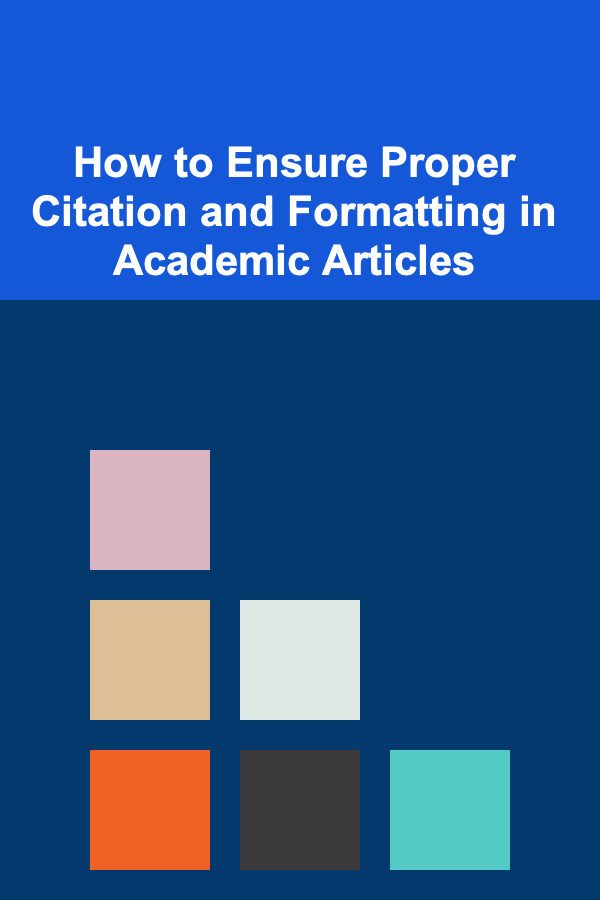
How to Ensure Proper Citation and Formatting in Academic Articles
ebook include PDF & Audio bundle (Micro Guide)
$12.99$7.99
Limited Time Offer! Order within the next:

Academic writing is an essential skill for students, researchers, and professionals alike. Whether you are working on a research paper, thesis, or journal article, proper citation and formatting are crucial for ensuring the credibility and academic integrity of your work. This guide provides a comprehensive and actionable approach to understanding and applying proper citation and formatting in academic articles.
Why Proper Citation and Formatting Matter
Before diving into the specifics, it's important to understand why proper citation and formatting matter:
- Credibility and Authenticity: Proper citation acknowledges the contributions of other scholars, demonstrating that you have conducted thorough research. It also helps avoid plagiarism, which is a serious ethical violation in academia.
- Academic Integrity: By properly citing sources, you demonstrate respect for intellectual property and adhere to the academic community's standards.
- Clarity and Consistency: Correct formatting ensures that your work is easily readable and meets academic standards. It helps readers quickly locate cited sources, understand the structure of your article, and follow your argument.
Understanding Citation Styles
There are several citation styles used in academic writing, each suited to different disciplines. The most common ones include:
- APA (American Psychological Association): Widely used in the social sciences, such as psychology, education, and sociology.
- MLA (Modern Language Association): Common in the humanities, particularly in literature, philosophy, and arts.
- Chicago/Turabian: Often used in history, art history, and some social sciences.
- Harvard: Popular in the UK and Australia, commonly used in social and natural sciences.
- IEEE (Institute of Electrical and Electronics Engineers): Typically used in engineering and computer science.
Understanding the requirements of each citation style is essential. The following sections will explore the key elements of proper citation and formatting in academic writing.
Key Elements of Citation
1. In-Text Citations
In-text citations refer to the citations you include within the body of your paper. They are used to acknowledge the source of information that you quote, paraphrase, or reference.
-
APA: Includes the author's last name and the year of publication in parentheses. If quoting directly, you should also include the page number.
- Example: (Smith, 2020) or (Smith, 2020, p. 45)
-
MLA: Includes the author's last name and page number, with no comma between them.
- Example: (Smith 45)
-
Chicago: Depending on whether you are using the author-date system or notes and bibliography system, in-text citations may differ. In the author-date style, it is similar to APA.
- Example: (Smith 2020) or (Smith 2020, 45)
2. Reference List / Bibliography
The reference list or bibliography provides the full citation information for each source you reference in your paper. It should appear at the end of your document, and the format will differ depending on the citation style.
-
APA: Lists sources alphabetically by the last name of the first author. Include the author's name, year of publication, title of the work, and publication details.
- Example: Smith, J. (2020). The Study of Human Behavior. University Press.
-
MLA: Also lists sources alphabetically, but the format emphasizes the author's name, the title of the source, and publication details.
- Example: Smith, John. The Study of Human Behavior. University Press, 2020.
-
Chicago: The citation format depends on the style chosen (author-date or notes and bibliography), but both require the author's name, title of the work, and publication details.
- Example: Author-date: Smith, John. 2020. The Study of Human Behavior. University Press.
- Notes and bibliography: Smith, John. The Study of Human Behavior. University Press, 2020.
3. Direct Quotes vs. Paraphrasing
- Direct Quotes: When you quote directly from a source, you must include the exact wording within quotation marks, followed by a citation. Ensure you also include the page number (if applicable).
- Paraphrasing: When you rewrite someone else's idea in your own words, a citation is still required, but quotation marks are not needed. Paraphrased content should still be attributed to the original source.
Proper Formatting in Academic Articles
In addition to citations, proper formatting is another vital aspect of academic writing. Academic articles often follow strict guidelines regarding structure, headings, spacing, and font styles. Here's a breakdown of the essential elements to pay attention to:
1. Document Structure
Most academic articles follow a clear structure, which may vary depending on the type of paper (e.g., research paper, review article). The general sections often include:
- Title Page: Includes the title of the paper, author's name, institutional affiliation, and other required details (such as course information, if applicable).
- Abstract: A brief summary (150-250 words) of the article that outlines the main points, methodology, and conclusions.
- Introduction: Introduces the topic, provides background information, and states the research question or hypothesis.
- Literature Review: Reviews previous research relevant to your topic, highlighting key findings and gaps.
- Methodology: Describes how the research was conducted, including the methods, tools, and procedures used.
- Results: Presents the findings of your research, often using tables, graphs, or charts.
- Discussion: Interprets the results, explaining their significance and how they relate to your research question or hypothesis.
- Conclusion: Summarizes the main points and suggests areas for future research or practical applications.
2. Headings and Subheadings
Academic papers are typically organized with clear headings and subheadings to improve readability and structure. Each section of your article should be clearly marked with a relevant heading. The formatting of headings (font size, bolding, numbering, etc.) varies depending on the style guide.
For example, in APA style, the headings are divided into five levels, with the most important sections having larger font sizes and bolding. MLA typically uses simpler heading styles without numbering, while Chicago might employ a more flexible heading structure.
3. Font and Spacing
- Font : Most academic papers require a professional, easy-to-read font, typically Times New Roman in 12-point size.
- Spacing: Papers are generally required to be double-spaced, with no extra spaces between paragraphs. Additionally, there should be a 1-inch margin on all sides of the document.
- Page Numbers: Include page numbers in the header or footer of your document, depending on the style guide.
4. Quotations and Punctuation
- Block Quotes: For longer quotes (usually more than 40 words in APA or more than four lines in MLA), use block quote formatting. This means indenting the quote and not using quotation marks.
- Ellipses and Brackets: Use ellipses (...) to indicate omissions in a quote and brackets [ ] to add clarifications or changes in a direct quote.
Best Practices for Citation and Formatting
1. Consistency is Key
Whether you are following APA, MLA, Chicago, or any other style, the most important rule is consistency. Ensure that you follow the same citation style throughout your paper, both in the text and in the reference list.
2. Double-Check Your Sources
It's essential to double-check the accuracy of the sources you are citing. This includes verifying authorship, publication date, and other citation details. Errors in citation can diminish the credibility of your work.
3. Use Citation Tools
Consider using citation management tools, such as Zotero , EndNote , or Mendeley, which can help organize your references and format citations automatically. These tools can save you time and ensure accuracy, especially for complex sources.
4. Review Citation Guidelines
Before you submit your paper, review the citation guidelines provided by your institution or the journal you're submitting to. Small formatting errors can make a big difference in the final version of your work.
Conclusion
Proper citation and formatting are fundamental to producing high-quality academic work. By understanding the importance of these practices, learning the rules of various citation styles, and following the appropriate guidelines, you ensure that your research is credible, professional, and respected within the academic community.
With these tips, you are equipped to write articles that not only present compelling research but also adhere to academic standards of citation and formatting.
Reading More From Our Other Websites
- [Organization Tip 101] How to Keep Pet Supplies Safe from Pests and Critters
- [Organization Tip 101] Why Organizing Your Kitchen Drawers Can Save You Time Cooking
- [Organization Tip 101] How to Manage Screen Time for Kids with an Organized Approach
- [Home Soundproofing 101] How to Optimize Your Gaming Room Soundproofing for Clearer, Undisturbed Play
- [Personal Care Tips 101] How to Prevent Razor Burn on Sensitive Skin: Expert Tips and Product Recommendations
- [Home Rental Property 101] How to Create a Kid-Friendly Environment in Your Family-Friendly Rentals
- [Home Pet Care 101] First Aid Kit Essentials for Pet Owners
- [Horseback Riding Tip 101] Memorable Moments on the Saddle: Fun Activities for Friends on Horseback
- [Scrapbooking Tip 101] DIY Layout Templates: Printable Tools to Streamline Your Scrapbooking Process
- [Organization Tip 101] How to Organize Jewelry Supplies for DIY Projects

How to Create a Checklist for Customer Satisfaction and Feedback Analysis
Read More
How to Sell Used Appliances on OfferUp: An Actionable Guide
Read More
Performance Marketing Manager's Toolkit: Proven Tactics for Optimizing Campaigns
Read More
How to Deal with Panic Attacks
Read More
How to Track Marine Mammal Migration Patterns
Read More
10 Tips for a Yearly Financial Health Checkup
Read MoreOther Products

How to Create a Checklist for Customer Satisfaction and Feedback Analysis
Read More
How to Sell Used Appliances on OfferUp: An Actionable Guide
Read More
Performance Marketing Manager's Toolkit: Proven Tactics for Optimizing Campaigns
Read More
How to Deal with Panic Attacks
Read More
How to Track Marine Mammal Migration Patterns
Read More